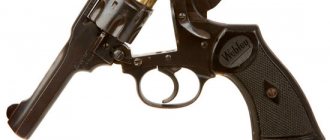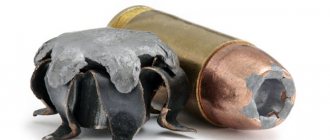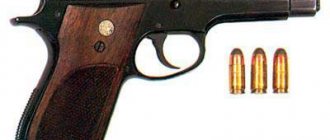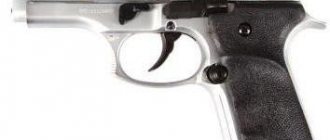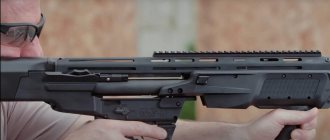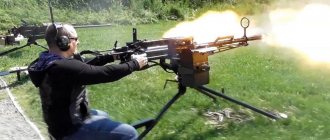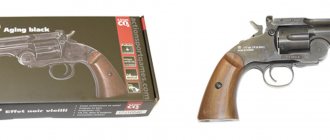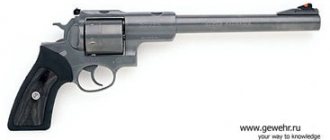The Smith & Wesson Model 29 .44 Magnum, or simply the .44 Magnum, is a revolver developed in the mid-1950s chambered in the powerful .44 Magnum cartridge. This weapon is very popular; directors in Hollywood and creators of computer shooters love it. The “Forty-fourth” Magnum can easily be called the most famous revolver in the world; it enjoys the greatest popularity in its homeland - in the United States of America. In Latin, the word “magnum” means “large”, “large”. The .44 Magnum fully lives up to its name - today it is the most powerful production revolver in the world.
The .44 Magnum was originally designed as a hunting weapon. It is believed that the .44 Magnum bullet is quite capable of taking down medium-sized game (for example, deer), but there is information about the successful use of this ammunition for hunting buffalo and even bear.
However, even more than that, the .44 Magnum helped Hollywood producers hunt for box office records. Thanks to the police detective nicknamed "Dirty Harry", brilliantly played by Clint Eastwood, the .44 Magnum revolver gained widespread popularity. There are numerous communities of .44 Magnum fans in the United States.
There are several modifications of 44 Magnums, they differ in barrel length. Despite the fact that this revolver gained fame and popularity thanks to the fictional police detective Harold Callahan, the police and other law enforcement agencies do not favor this weapon. Due to its large size, excessive ammunition power and extreme recoil.
History of the Magnum .44
The history of the Smith & Wesson Model 29 .44 Magnum revolver began in 1955. This weapon was developed by the famous shooter, hunter and Smith & Wesson engineer Elmer Keith and chambered in the very powerful .44 Remington Magnum cartridge. Initially, the design of the revolver was based on the ability to withstand high pressure during a shot. Of all the revolvers of the illustrious company, the 44 Magnum has the most durable frame.
The .44 Magnum cartridge was originally designed for hunting. Elmer Keith took the .44 S&W Special cartridge, created back in 1907, as a basis and worked on it for a long time. After lengthy experiments, he managed to select a bullet weight at which its initial speed was 460 meters per second. During testing, the new cartridge was able to provide twice the bullet energy of the .357 Magnum ammunition. The company's management was satisfied with the results of the research and decided to begin industrial production of the cartridge. The only trouble was that at that time Smith & Wesson did not have free production capacity to produce a new cartridge. I had to look for partners.
The cartridge was produced by the equally famous American company Remington Arms, so the cartridge in the future received the full name .44 Remington Magnum. Well, the incomplete and most popular is .44 Magnum.
The end result was that the .44 Magnum was slightly longer than the .44 S&W Special from which it was based. Later, various modifications of this cartridge were created.
The revolver, chambered for the .44 Magnum cartridge, was called the Smith & Wesson Model 29. However, it is often called simply the .44 Magnum.
Model 10 Options
| Model | Year | Modifications |
| 10 | 1957 | Introduction |
| 10-1 | 1959 | Heavy barrel introduced |
| 10-2 | 1961 | Replace extractor rod thread for standard barrel |
| 10-3 | 1961 | Change extractor rod threads for heavy barrel, change front sight width from 1/10" to 1/8" |
| 10-4 | 1962 | Removing the trigger guard screw on a standard receiver frame. |
| 10-5 | 1962 | Change the sight width from 1/10" to 1/8" on a standard barrel. |
| 10-6 | 1962 | Removing the trigger guard screw on a frame with a heavy barrel |
| 10-7 | 1977 | Replacing the gas ring from a fork to a cylinder for a standard barrel |
| 10-8 | 1977 | Replacing the gas ring from a fork to a cylinder for a heavy barrel |
| 10-9 | 1988 | Replace fork mounting system, radial stud package, hand hammer nose floating bushing for stock barrel. |
| 10-10 | 1988 | Replace fork mounting system, radial stud package, heavy barrel hand hammer nose floating bushing |
| 10-11 | 1997 | MIM Hammer/Trigger and Floating Striker for Standard Barrel and Heavy Barrel HB Model M10 Park Police. |
| 10-12 | 1997 | Hammer/MIM trigger + floating striker for heavy barrel |
| 10-13 | 2002 | Anniversary edition 1899 limited edition |
| 10-14 | 2002 | Added internal lock |
| 10-14 | 2010 | Out of production |
| 10-14 | 2012 | Re-introduced as part of the classic line |
.357 Magnum variants
After a small prototype run of Model 10-6 revolvers in .357 Magnum, Smith & Wesson introduced the Model 13 in heavy carbon steel, followed by the Model 65 in stainless steel. Both revolvers had different weights and barrel lengths - usually three and four inches with and without caps (casings). The Model 13's production run begins in 1974 and ends when production ceases in 1999. The Model 65 was produced from 1972 to 1999.[2] Both blued and stainless steel models were popular with police and the FBI, and a Model 65 variation was sold in the Lady Smith line from 1992 to 1999.
.38 S&W variants
From the late 1940s to the early 1960s, Smith & Wesson developed a variant of the Model 10 chambered in .38 S&W called the Model 11.[15] which was sent to the British Commonwealth countries to supply their armies[15] and police forces.[16] They were sent to Canada as well.[17]
Dirty Harry
This weapon was not particularly popular or in demand for a long time. Only a few hunters and sports shooting enthusiasts bought it. This was until 1971, when the first film about the brutal guy Harold Callahan, a police detective from San Francisco nicknamed “Dirty Harry,” was released. This character hated paperwork, and in his work he relied more on a huge 44-caliber revolver than on the wisdom of the criminal procedure code. Callahan was played by the magnificent Clint Eastwood, and the Smith & Wesson Model 29 was chosen as his weapon.
After the screening of this film, both Clint Eastwood and the Magnum 44 revolver turned into real cult figures for Americans. The 44 Magnum began to quickly sell out, which allowed the manufacturing company to sell more than half a million units of this weapon of various modifications. It should be noted that before filming the film, Clint Eastwood practiced shooting the .44 Magnum for over a month. Therefore, on the screen he easily and casually handled this weapon.
Replacement
The S&W Model 10 revolver was a popular weapon until the semi-automatic pistol replaced the revolver in many police departments, as well as in police units and armies.
- Some Irish Gardaí (Irish Police) units have replaced the Model 10 with SIG Sauer P226 and Walther P99 C self-loading pistols.
- Victoria Police replaced the Model 10 K frame with the M&P in .40 S&W.
- New Zealand police replaced the revolver with a Glock 17.[10]
- NSW Police have replaced the Model 10 with Glock 22, Glock 23 and Glock 27.
- The weapon was used by the Norwegian Home Guard until 1986 and the Norwegian Police Service until 2008, being replaced by the Heckler & Koch P30
- Portuguese police changed the weapon to a Walther PP and then a Glock 19.[10]
- The Royal Malaysian Police used the Model 10 as their standard sidearm from early 1970 alongside the Model 15 until it was completely replaced by the Beretta PX4 and Walther P99. It was used by the Police Volunteer Reserve as their standard sidearm, and by the RELA Corps for training and self-defense of its officers, along with the Smith & Wesson Model 36 2-inch Barrel.[10]
- The Model 10 was formerly the standard model for many police firearms trained officers in the United Kingdom and has been replaced by the Glock 17 in many forces.[10]
- The weapon was used by the US Army and US Marine Corps, only to replace the M1911A1 and pistols.[10] Before the introduction of the M9 pistol in 1985, the Army and Marine Corps produced Model 10s for aircrew members and policewomen (both officers and enlisted MPs). Snub-nosed versions were used by Criminal Investigation Department (CID) agents.
Description Magnum .44
The Smith & Wesson Model 29 is a classic American double-action revolver chambered in .44 Magnum. Due to the power of the ammunition used, it has a reinforced design.
The extraction of cartridges occurs simultaneously according to the most common principle today: the drum is tilted to the side, and then the shooter uses an extractor to remove the cartridges from the chambers.
The .44 Magnum has multiple barrels. Initially there were three versions of the weapon: with barrels 6½ inches, 8⅜ and 10 inches long. Later, “short barrels” were added to them - 4 (102 mm) and 6 inches (153 mm).
Naturally, the weight of the weapon greatly depends on the length of the barrel.
The revolver was originally designed for the .44 Magnum cartridge, but the design of the revolver (the absence of a bolt and magazine) allows the use of other 44-caliber ammunition. The .44 Magnum even accepts black powder ammunition such as the .44 Russian or .44 Special.
The sights of the revolver are open; they consist of a front sight and rear sight, which are coated with phosphorus. To partially reduce recoil, the revolver has a heavy and comfortable handle.
The .44 Magnum has a double action trigger and the weapon's drum has a capacity of six rounds.
Smith and Wesson revolvers
At the suggestion of the famous specialist Major General A.P. Gorlov and Colonel Yuryev, the American revolver was chosen to arm the Russian army. Back in 1855, in the USA, Horace Smith and Daniel B. Wesson received a patent for a revolver chambered for a unitary cartridge with a metal sleeve (White’s idea). The patent expired in 1869, competitors were already preparing to launch their models of revolvers with “through chambers” onto the market, and this threatened serious financial losses. This was to be prevented by a new model chambered for the .44 caliber centerfire cartridge, known as the Smith & Wesson American Model No. 1, with a breaking frame and simultaneous extraction of cartridges (Dodge and King patents). This model earned the approval of the commission convened in St. Louis, and attracted the attention of Gorlov. In September 1870, Major General Gorlov was able to become more familiar with the company's new model, known in the USA as Smith & Wesson Model No. 3.
4.2-line revolver "Smith and Wesson second model" 1872
A Smith & Wesson revolver in the open loading position. The extended extractor, barrel latch, and side frame cover are clearly visible
The revolver was recognized as meeting the requirements for a soldier's combat weapon and they asked for the “highest permission” to purchase 20 thousand pieces with an appropriate supply of ammunition. On May 1, 1871, it received the first order for 20,014 revolvers. The weapon was given the official name “4.2-line Smith and Wesson revolver.” This model, with a barrel length of 8 inches (203.2 mm), is known as the Smith & Wesson I pattern. “4.2 lines” (i.e. 0.42 inches) did not mean a reduction in caliber compared to the prototype - it was simply measured by the rifling fields of the barrel, unlike the American 44, measured by the diameter of the bullet. On the contrary, Russian experts insisted on increasing the diameter of the bullet, while the obturation of the powder gases was improved and, despite the weight of the bullet, the initial speed increased and the accuracy of fire improved. The cartridge consisted of a solid-drawn brass sleeve with a protruding rim, a charge of black gunpowder weighing 1.42 g, a jacketless lead bullet weighing 14.9 g (3.5 spools) with two annular grooves, and a central Berdan-type capsule. The part of the bullet protruding from the cartridge case became greasy.
Smith and Wesson revolvers in Russia - like their peers, Berdan rifles - were considered “small-caliber”, which is not surprising - before that, small arms of the Russian army had a caliber of 6 lines.
Drawing from J. Scofield's patent for a revolver reloading system used in the Smith & Wesson scheme
Design and operation of the Smith and Wesson revolver mechanisms: 1 - barrel, 2 - drum, 4 - hinge and gear, 5 - barrel latch (clasp), 6 - axis, 7 - drum stop, 8 - screw, 11 - lock delay, 12 — extractor star, 13 — extractor stem, 14 — ratchet teeth, 15 — pawl, 16 — axis, 17 — frame shield, 18 — rack, 19 — rod, 20 — spring, 21 — extractor latch, 22 — gear latch, 23 - wheel cutout, 24 - barrel protrusion, 25 - latch spring, 26 - oppressor, 27 - trigger, 28 - trigger mane, 29 - chain, 30 - mainspring, 31 - spring branch, 32 - cocking , 33 — descent sear
The design of the revolver consisted of the following main parts: barrel, drum, frame with handle. The barrel with the drum was attached to the frame at two points - it was connected to it by a lower hinge and secured with an upper latch, had a bar (“comb”) on top, and a bulge-case for the ejector rod on the bottom. There were five right-hand rifling in the barrel. The barrel bar increased its rigidity and made it possible to reduce the height of the front sight, making it a little easier to remove the weapon from the holster. The drum had 6 chambers, its central tube was placed on a tubular axis, and on the side surface of the drum there were recesses into which the end of the delay dropped.
When the barrel was tilted down, a special latch at the bottom of the frame turned a gear, which captured the rack and pulled back a star-shaped extractor from the drum, pushing out the cartridges. At the end of the turn, the gear broke off the latch, and the ejector, under the action of its spring, returned to the recess in the rear end of the drum (this extraction scheme was patented in the USA in 1871 by Major J. Scofield). Note that when choosing a revolver, Russian experts paid attention to the reloading speed.
The design of the 4.2-lin Smith and Wesson revolver cartridge is a center-fire cartridge with a jacketless lead bullet, a charge of brown black powder and a solid-drawn brass sleeve. The edge of the sleeve is formed by a fold at the bottom
Revolvers produced by Smith & Wesson - “Russian model” (corresponding to the Smith & Wesson II model) and “improved Russian model” with a modified frame and a shortened extractor
The trigger mechanism (“lock”, as it was called then according to tradition) with an open rotary trigger was assembled in a frame. The trigger was made integral with the firing pin and was connected to a plate mainspring by a chain. The shot was fired only with preliminary cocking of the hammer. Before firing, the hammer had to be cocked by the spoke, while a pawl hinged on it, pressing on the gear of the drum base, rotated the drum one step. When the trigger was cocked, the sear raised the drum delay.
To load the revolver, the trigger had to be put on the safety cock - in this case, the delay was lowered, and the drum could rotate freely. Then it was necessary to lift the latch and, unlatching the frame, turn the barrel down - “open” the revolver, fill the cylinder chambers with cartridges, “close” the revolver by lifting the handle, and fasten the latch. If the Smith & Wesson fired the first 6 rounds in 6 seconds, then with subsequent reloads the rate of fire reached 24 rounds in two minutes - a good indicator for those years.
Smith and Wesson revolvers made in Berlin differed little from American ones
Smith & Wesson hinge, drum and latch. You can clearly see the fastening of the latch and how the upper recess of the trigger additionally fixed the barrel when firing
In 1872, Smith and Wesson II model appeared. On January 15, 1873, Gorlov signed a second contract with the company for a lightweight model with a barrel shortened to 7 inches (177.8 mm). In addition to the shortening of the barrel, there were other changes - an extractor stop was introduced, a “heel” appeared on the back of the frame above the handle, which prevented it from moving in the hand under the influence of recoil. The spur on the trigger guard under the middle finger also provided greater stability. This unusual detail for military weapons allegedly appeared thanks to... a horse hunt organized by the US government for Grand Duke Alexei Alexandrovich during his visit at the end of 1871. The Grand Duke considered it necessary to improve the convenience of shooting a revolver from a horse.
Russia, by the way, was one of the first to adopt a “metal” unitary central-ignition revolver cartridge into service with the army and was perhaps the first to appreciate the merits of the Smith and Wesson scheme.
Smith and Wesson Model III revolver manufactured by ITOZ - right and top view
Markings on the barrel of a revolver produced to Russian order
In 1880, the Smith and Wesson III model appeared. The length of the barrel was reduced by another 0.4 dm, the front sight was made integral with the barrel, and the barrel was connected to the frame with a rod and screw. A latch was introduced that disables the extractor - this made it possible not to throw away unfired cartridges when unlocking the weapon. The extractor has been shortened. A bullet fired from a revolver, at a distance of 25 steps (17.78 m), pierced 3-4 pine boards one inch (25.4 mm) thick, placed an inch from one another.
The markings of American-made revolvers included the Russian coat of arms and the inscription “Smith and Wesson Arms Factory, G. Springfield America” and the serial number on the barrel strap. Metal parts were covered with bluish bluing or nickel plated; the cheeks of the handle were usually made of walnut wood. The revolver was worn in a leather holster, the valve of which completely covered the weapon. In the cavalry, in addition to the revolver, six cartridges were carried in a holster. The safety cord was attached at one end to a ring screwed into the handle of the revolver, the other end of which ended in a wide loop that was worn around the neck over the standing collar of the uniform. Note that the revolver was carried with the handle forward - it was believed that it was more convenient to draw a relatively long weapon.
Smith & Wesson III revolver with holster
A five-shot revolver of the Smith and Wesson system, designed to look like a Caucasian pistol, with a nipple trigger - possibly commissioned by an officer of the Caucasian Cossack Army
There were, of course, decorated specimens with engraving, gold or silver notches, and mother-of-pearl cheeks. The order from the Russian government for the Smith and Wesson Model II was received by the Berlin industrialist Ludwig Lewe. The only difference between German revolvers and American ones was the inscription: “Ludwig Löwe, Berlin.” As in the case of Smith & Wesson, a large Russian order helped Ludwig Loewe establish itself in the arms market - later the company manufactured Maxima machine guns for Russia.
Finally, in 1886, the release of the third Smith and Wesson model and cartridges for it was supplied by the Imperial Tula Arms Factory. In total, ITOZ produced 31,435 revolvers. In addition to the mass-produced ones, experimental versions of 1872 with an elongated barrel and a detachable butt were produced. From 1876 to 1891, revolvers suitable for concealed carry were produced in small series for the criminal police, mainly by altering the military Smith and Wesson with the barrel shortened to 90 mm and the trigger guard spur removed. Samples of reduced calibers and sizes were also made (“small Russian Smith and Wesson” in .38 caliber). Note that, in addition to Russia, Smith & Wesson chose Australia and Japan for this system. A couple of interesting facts - “Smith and Wesson of the Russian model” was purchased by the Turkish army, so during the Balkan War of 1877-1878. They were used by both sides, copies of these revolvers were produced in Spain, and the Spanish army used them in 1898 in battles with the Americans in Cuba. “Smith and Wesson of the Russian model” was copied in Belgium. Later, similar Smith & Wesson revolvers were purchased for the Japanese Navy and the Argentine National Guard. Smith & Wesson produced its “Russian model” until 1912. For a long time, the cartridge for the “Russian” Smith & Wesson model, which became known as the “.44 Russian” (“Russian”), was popular on the American market. And the modification of the Smith and Wesson Model II, but in .38 caliber, received the nickname “Baby Russian” in the same market.
Belgian copy of the “Russian Smith-Wesson”
4.2-line Smith & Wesson revolver (without trigger guard spur) in the shooter's hand
The attitude towards the Smith and Wesson revolver among the troops was ambiguous. Many noted its cumbersomeness. “Weapons Collection” No. 1 for 1895 (on the eve of the adoption of the Nagan revolver) wrote: “Dislike for Smith-Wesson revolvers in our army is strongly developed,” since they “by their severity do not justify purely combat benefits, but as a firearm weapons are already outdated.” However, opinions were also expressed that “in addition to its excellent fighting qualities, as a firearm itself, this revolver in hand-to-hand combat is an equally excellent edged weapon in its massiveness and in the crushing nature of the blows it inflicts.” Evaluation of personal weapons from the point of view of “strikes delivered” (or, more simply, “what if you hit someone on the head with the handle”) was also encountered later.
The Nagant revolver, adopted for service in 1895, could not immediately supplant the Smith & Wesson. The army units were the first to part with their old revolvers. For some time, the Smith and Wessons remained in service with the police and the Separate Corps of Gendarmes, then they ended up in warehouses and in private hands. Later, revolvers surfaced during the revolutions of 1905 and 1917, and after the lawlessness of the Civil War, they walked for a long time in the criminal environment. Well-preserved copies of the Smith-Wessons, as well as Lefoshe revolvers, can still be found in our country to this day.
A decorated Smith & Wesson Model 3 Navy revolver in .44 Russian caliber with a self-cocking trigger mechanism and a 6.5-inch barrel length—possibly prepared by the company for a gift to Russia in the hope of promoting the model into service with the Russian army
Tactical and technical characteristics of "Smith and Wesson" mod. 1880
- Caliber - 10.66 mm
- Cartridge - 4.2-lin revolver
- Weight of weapon without ammunition - 1.2 kg
- Weight of weapon with loaded drum - 1.328 kg
- Weapon length - 300 mm
- Barrel length - 167.6 mm (6.6 inches)
- Weapon height - 135 mm
- Weapon width - 43 mm
- Number of grooves - 5
- Rifling stroke length - 45 calibers (477 mm)
- Initial bullet speed - 200 m/s
- Muzzle energy of a bullet - 330 J
- Drum capacity - 6 rounds
- Extraction of cartridges - simultaneous, with a star-shaped extractor when tilting the barrel down
- The dispersion radius at a distance of 25 steps is 26 cm, 50 steps is 44 cm.
Share link
Advantages and disadvantages of Magnum .44
Like any other weapon, the Magnum 44 revolver has both significant advantages and certain disadvantages.
The revolver was originally designed for hunting, but sometimes it is bought for self-defense, sport shooting, or just to create a cool image. One thing to remember when purchasing this weapon is that the .44 Magnum has a very tough temperament, comparable only to that of its famous owner, “Dirty Harry” Callahan.
This revolver has very harsh recoil. If you have a weak hand, then using the .44 Magnum will be very difficult (up to a blow to the head). However, the harsh appearance of the pistol can scare off the enemy. If not, then one accurate shot will be more than enough. The massive design allows the 44 to be used even in hand-to-hand combat.
Speaking seriously, the main advantages of weapons are:
- excellent accuracy;
- possibility of use as a second hunting weapon;
- very powerful cartridge with good penetration and stopping effect;
- the ability to use other 44-caliber ammunition;
- a threatening appearance that has a strong psychological impact;
- high reliability of weapons.
Of course, the .44 Magnum has some serious drawbacks that you need to consider before purchasing this revolver. The most important of them is the significant recoil, which can easily “knock out” the hand of an inexperienced shooter. Also, you are unlikely to be able to conduct high-speed aimed fire from a Magnum 44. The sound of a shot is deafening, and the flash can blind anyone. The revolver is very heavy, the lightest modification weighs more than 1,220 kg. In addition, the 44 is quite bulky and not intended for concealed carry.
It should also be noted that both the revolver and its ammunition are quite expensive. However, the .44 Magnum is not only a weapon, but also an element of image, which, as we know, is more valuable than money.
It should be noted that the .44 Magnum cartridge is also used by other types of small arms. Among them are such recognizable pistols and revolvers as the Desert Eagle, Colt Anaconda and .44 Magnum Ruger Blackhawk. Almost all of them fit the definition of “pocket howitzers”.
